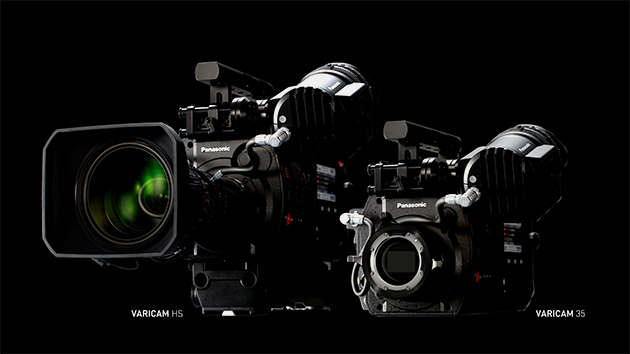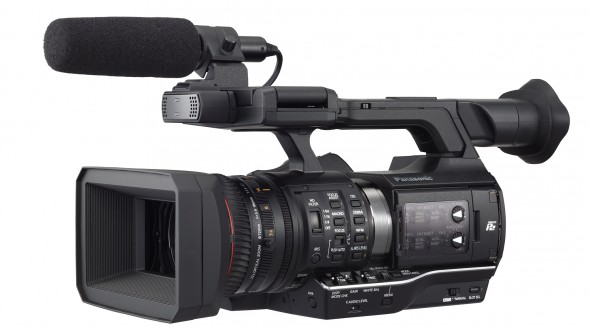New AJ-PX270 AVC-Ultra Camcorder Is Geared Toward Flexible, Wireless Workflows
Panasonic finally committed to its 4K VariCam strategy at a press briefing in New York City today, when it actually announced two new cameras under the VariCam brand. The "4K VariCam" that was first shown as a mock-up at NAB 2012 has become the VariCam 35, with a Super 35mm sensor and 4K raw recording capability. Meanwhile, Panasonic is targeting sports photography with the VariCam HS, a high-speed 2/3-inch camera that reaches up to 240fps — with the ability to ramp frame rates during recording — in full-raster 1080p using the AVC-Intra 100 codec.
Panasonic also announced the ExpressP2 card and drive, a format that can facilitate fast offload of camera footage at speeds of up to 2.4 Gbps. Each camera will have two expressP2 and two microP2 card slots. The new VariCams, as well as a single-slot expressP2 drive, are expected to arrive this fall — "in time for the World Series," as Panasonic Senior Product Manager Steve Cooperman put it.
Lots of details on the new cameras are being saved for NAB, but Panasonic officials laid out the basics. The VariCam 35 uses a new Super 35mm MOS-type sensor that records native 4K (4096×2160) and UHD images as well as 2K and HD. It is rated at 14 stops of latitude, and the highest quality footage can be recorded in a 12-bit log raw implementation. It records at variable speeds of up to 120fps, has 24-bit LPCM audio in camera, boasts a new OLED viewfinder, and supports ACES workflows. Panasonic is stressing flexibility, and the VariCam 35 is said to allow simultaneous recording of 4K/UHD footage, 2K/HD reference output, and proxy recordings (at bit rates from 6 Mbps to 1.5 Mbps) for on-set color-grading, monitoring, and editing. It's a 35mm PL-mount camera with a removable control panel designed for easy access when the camera is in a fixed position.
Panasonic also stressed the camera's live output capability — it has four 3G HD-SDI connectors enabling live 4K and raw output. "This camera will allow you to have live workflows," Cooperman said. "One of the missing areas of 4K is live, whether it be live production for videos or live events." Wireless workflows with proxy streaming are also possible.
The biggest question was left unanswered — pricing will be announced closer to the camera's fall ship date.
The story was much the same for the VariCam HS, which features newly developed 1920x1080p 3MOS imagers, making it a third-generation VariCam. Using the AVC Ultra codec, it records 12-bit 4:4:4 (only to ExpressP2 cards) for field mastering and archiving and 4:2:2 10-bit for documentary and sports photography using the AVC Ultra codec. That 240fps frame rate is only enabled when recording to AVC-Intra Class100. If you want to record to AVC-Intra Class200, you'll be limited to 30p and 60i, and AVC-Intra Class4:4:4 recording is limited to 30p.
A new modular design style is being adopted for both of the cameras, with the respective camera heads able to separate from the recording module unit and function as tethered box cameras for use on jibs and cranes. The company said the camera heads will be interchangeable, allowing users to switch them out as needed.
Closer to reality is the new AJ-PX270 P2 camcorder, Panasonic's second camera, after the AJ-PX5000, to incorporate the AVC Ultra family of codecs—and the first handheld camera to do so. It comes with a fixed 22x zoom lens (28mm to 616mm 35mm-equivalent) with zoom, focus and iris rings and shoots at selectable frame rates between 1 and 60fps.
It's actually a five-pound, 1/3-inch camera with new 2.2Mpix MOS sensors, but the company says it's designed to perform more like a 2/3-inch unit. For example, according to Cooperman, the PX270 has "the most creative controls we've ever put in a handheld camera." He noted that the camera has extensive, VariCam-like image settings, including seven-mode gamma selection, that should make it a good choice for multi-camera shoots where it has to match a different A camera as closely as possible. It has HDMI and HD-SDI out, genlock and timecode, and a USB 3 host mode that allows you to plug in a standard USB drive and offload P2 content to disk. The camera also has two MicroP2 card slots, one P2 slot, and an SD card slot. (Yes, you can record footage to an SD card if you need to, at bit rates of 50 Mbps and below.)
The PX270 is designed to give shooters lots of options when it comes to recording. The camer'as standard high-quality recording mode is 100 Mbps AVC-Intra100, but 200 Mbps AVC-Intra200 recording will be possible through an optional future upgrade. The camera's AVC-LongG implementation is designed specifically for wireless feeds, or any other situation where bandwidth is at a premium, and allows recording to 10-bit 4:2:2 sampled AVC-LongG codecs at at bit rates of 50 Mbps, 25 Mbps, and even 12 Mbps. A high-resolution AVC-Proxy file can be encoded in parallel with production formats at bit rates from 6 Mbps all the way down to 800 kbps. And the camera supports legacy formats: DVCPRO HD, DVCPRO50, DVCPRO and DV.
What's really new with the PX270 is an emphasis on robust wireless workflow, including the ability to stream content and transfer it via FTP over networks. Later this year, a 4G adapter is slated to be available, allowing content to be transmitted over a 4G network. Also new is an workflow with Panasonic's cloud partner Aframe that Cooperman said will enable direct FTP upload of proxy-level footage from the camera into the cloud. An optional wireless LAN adapter will be available to support live uplinks.
The PX270 is slated to ship in March at a suggested list price of $6,350 $6,495, and Panasonic is promising a big push for the camera at its NAB booth in April.
Crafts: Shooting
Sections: Technology
Topics: New product 4k varicam aj-px270 nab 2014 P2 Panasonic varicam varicam 35 varicam hs wireless
Did you enjoy this article? Sign up to receive the StudioDaily Fix eletter containing the latest stories, including news, videos, interviews, reviews and more.











how can i buy this
how much is this